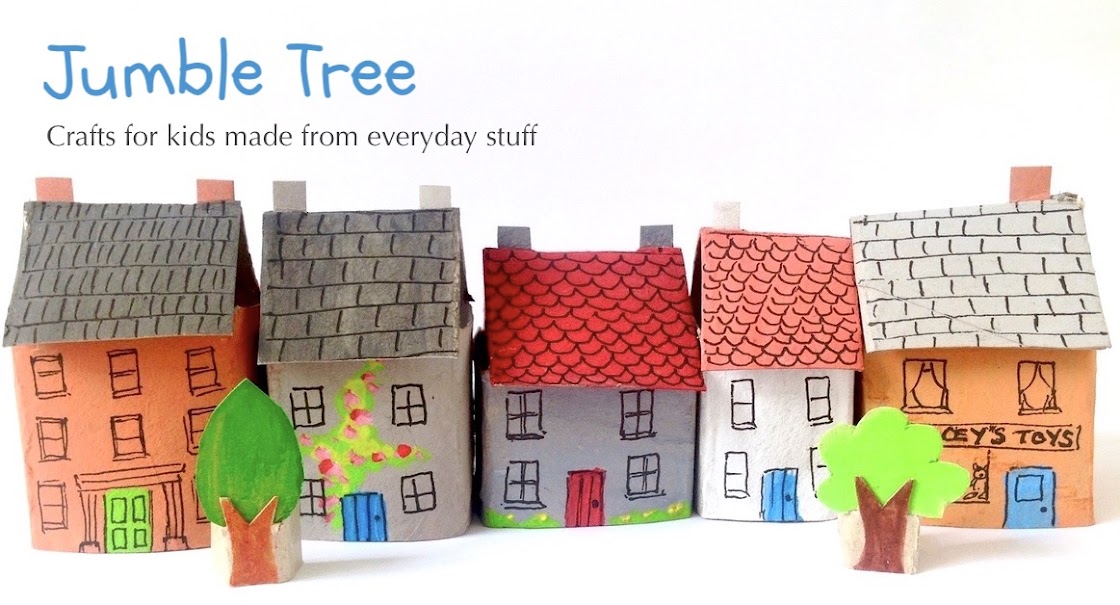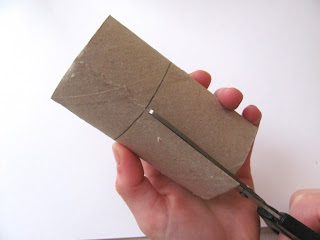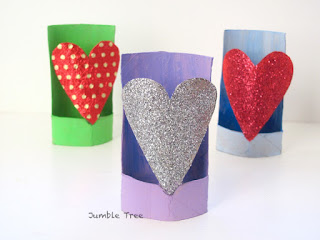Sometimes a craft idea just makes me happy... and this is one of them.
They're often the simplest ideas, and though the chairs mightn't look that simple, honestly, they really are. Each one is made from a single toilet paper tube, and you won't even need any glue.
You will need:
Toilet paper tube (for each chair)
Toilet paper tube (for the table, narrow if possible)
Cereal box card (for table top)
Scissors
Ruler
Pencil
Paint
Craft glue
1. Flatten a tube with the palm of your hand and press firmly all the way down the two creases.
2. Squeeze the tube back into shape, carefully line up the two creases you've just made, and flatten again with the palm of your hand, pressing firmly along the new creases. You'll now have four evenly spaced creases.
3. While the tube is still flat, draw a line across the tube, 4cm from one end. (This will be the height of the seat part of your chair. Check this in relation to your kitchen - you may want it to be higher)
4. Cut down all the creases to the line (from the longer end) and bend out THREE of the flaps, pressing firmly along the fold.
5. Shorten the two flaps either side of the one you didn't bend (the back of the chair). The flaps should be about a cm or so.
6. Bend the front flap inwards, creasing it where it meets the back of the chair, and then snip off the extra, leaving a cm or so (to tuck into the back of the chair). Press firmly along this crease.
7. You can stop here for younger makers - just bend the side flaps inwards, and tuck in the front flap (trim the sides of this flap a little if you need to, for a neat fit). Move to step 13.
9. Then, draw chair legs either side of the creases - try to keep them even, and cut up to the line, OR, have a go at cutting up to the line without the pencil guidelines, keeping the cuts as even as you can. It's easier (and quicker) than you think!
10. Bend each flap of card between the legs outwards, fold on the line and cut off.
11. Squeeze the chair back into shape, press along all the creases one more time, and then fold in the flaps. You may need to trim the sides of the seat flap to get it to fit in neatly. You shouldn't need glue, but if the seat part is popping out, put some glue on the flap and use a paper clip to hold it in place while the glue dries.
12. (OPTIONAL) If you would like to add some detail to the back of the chair, you could draw some rectangles (or a different shape) here, and use some small, sharper scissors, like nail scissors to pierce a hole through the card (put a piece of plasticine/modelling clay behind the card, so there's something to push against). Then carefully cut out the shape.
14. Make lots of small cuts down the tube to the line and firmly bend and fold back all the flaps.
15. Cut the top of your table from a piece of cereal box card. Ours is 10cm long by 7cm wide, and then we made about a cm fold along the length of the table on both sides (to make it look thicker), but leave this part out if you want to.
16. Glue the base to the middle of the table top and leave it upside down with something on top of the tube, to weigh it down while the glue dries. Then, paint your table and chairs any colour you want.
We went for a wood effect..




































































